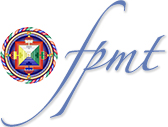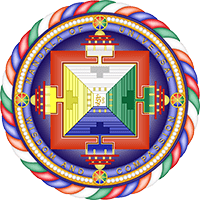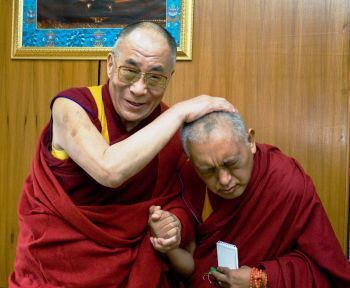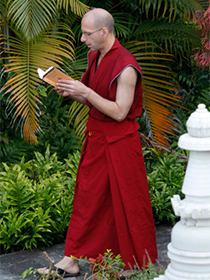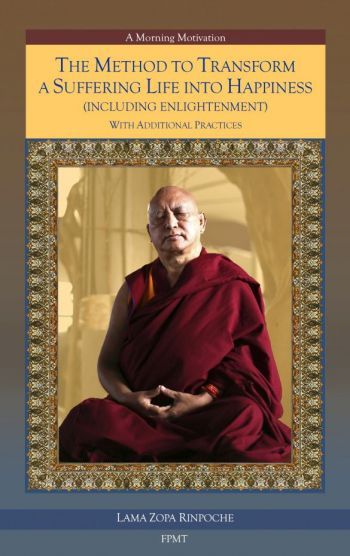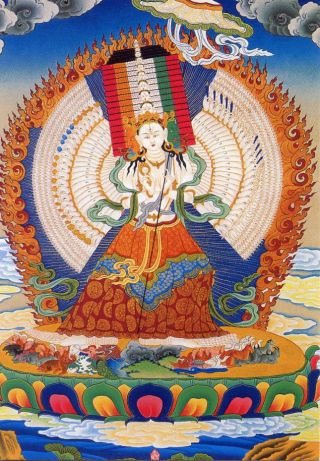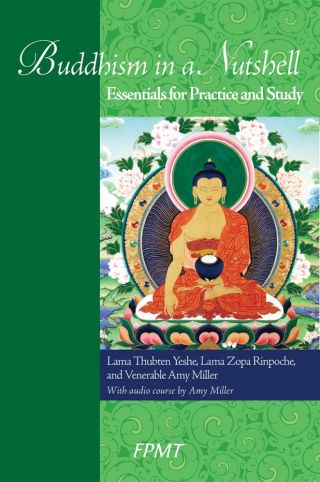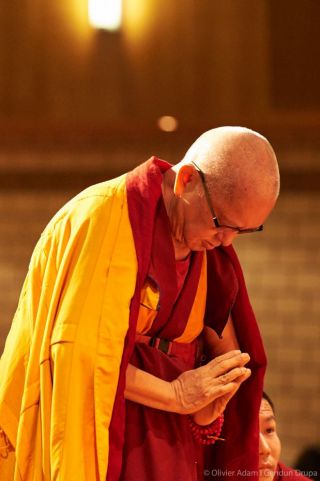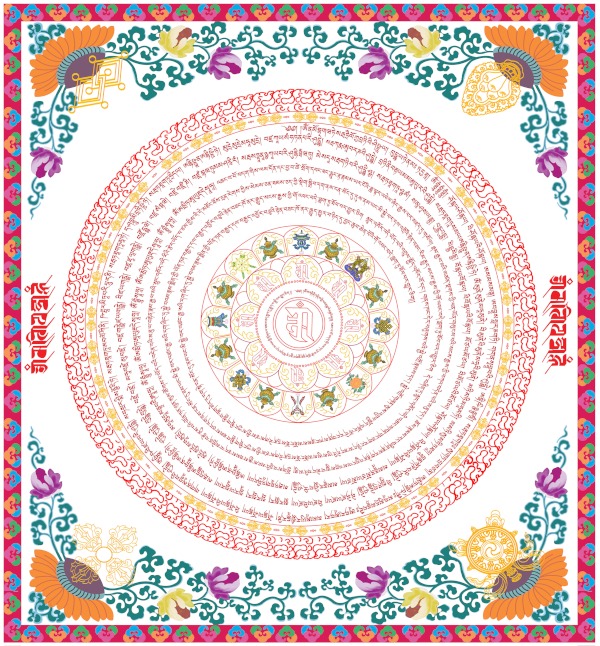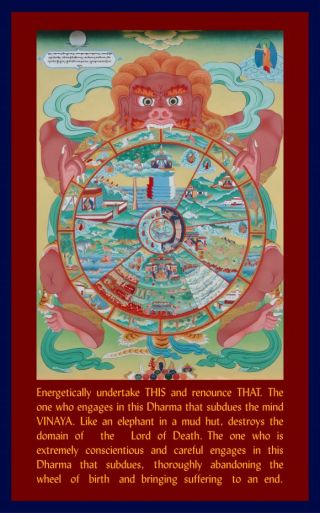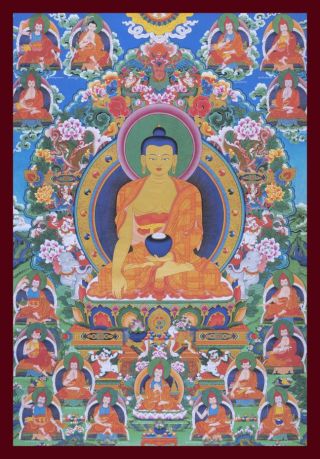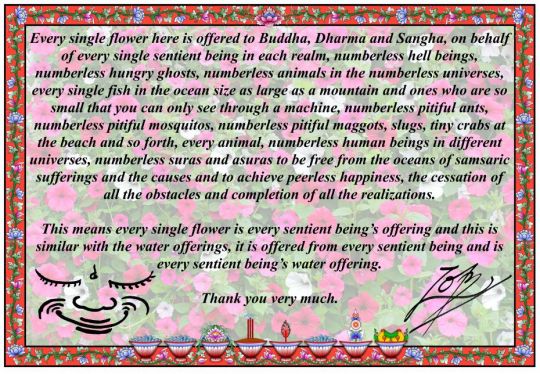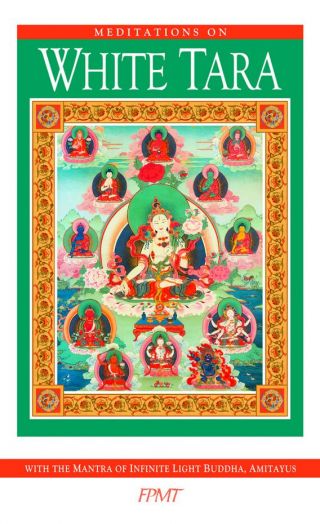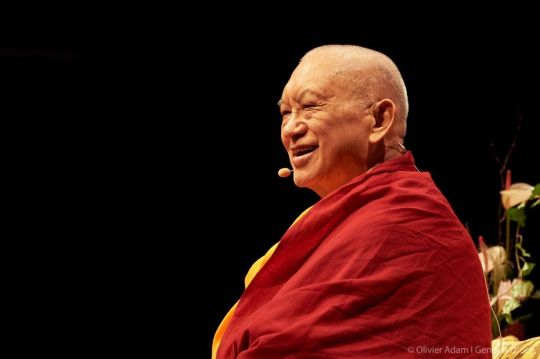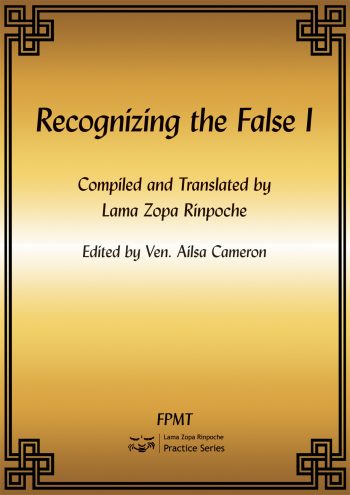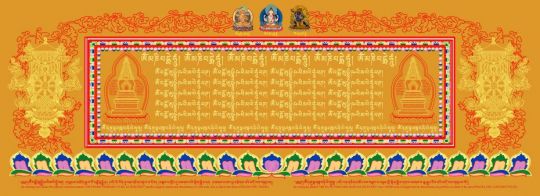- Home
- FPMT Homepage
Foundation for the Preservation of the Mahayana Tradition
The FPMT is an organization devoted to preserving and spreading Mahayana Buddhism worldwide by creating opportunities to listen, reflect, meditate, practice and actualize the unmistaken teachings of the Buddha and based on that experience spreading the Dharma to sentient beings. We provide integrated education through which people’s minds and hearts can be transformed into their highest potential for the benefit of others, inspired by an attitude of universal responsibility and service. We are committed to creating harmonious environments and helping all beings develop their full potential of infinite wisdom and compassion. Our organization is based on the Buddhist tradition of Lama Tsongkhapa of Tibet as taught to us by our founders Lama Thubten Yeshe and Lama Thubten Zopa Rinpoche.
- Willkommen
Die Stiftung zur Erhaltung der Mahayana Tradition (FPMT) ist eine Organisation, die sich weltweit für die Erhaltung und Verbreitung des Mahayana-Buddhismus einsetzt, indem sie Möglichkeiten schafft, den makellosen Lehren des Buddha zuzuhören, über sie zur reflektieren und zu meditieren und auf der Grundlage dieser Erfahrung das Dharma unter den Lebewesen zu verbreiten.
Wir bieten integrierte Schulungswege an, durch denen der Geist und das Herz der Menschen in ihr höchstes Potential verwandelt werden zum Wohl der anderen – inspiriert durch eine Haltung der universellen Verantwortung und dem Wunsch zu dienen. Wir haben uns verpflichtet, harmonische Umgebungen zu schaffen und allen Wesen zu helfen, ihr volles Potenzial unendlicher Weisheit und grenzenlosen Mitgefühls zu verwirklichen.
Unsere Organisation basiert auf der buddhistischen Tradition von Lama Tsongkhapa von Tibet, so wie sie uns von unseren Gründern Lama Thubten Yeshe und Lama Thubten Zopa Rinpoche gelehrt wird.
- Bienvenidos
La Fundación para la preservación de la tradición Mahayana (FPMT) es una organización que se dedica a preservar y difundir el budismo Mahayana en todo el mundo, creando oportunidades para escuchar, reflexionar, meditar, practicar y actualizar las enseñanzas inconfundibles de Buda y en base a esa experiencia difundir el Dharma a los seres.
Proporcionamos una educación integrada a través de la cual las mentes y los corazones de las personas se pueden transformar en su mayor potencial para el beneficio de los demás, inspirados por una actitud de responsabilidad y servicio universales. Estamos comprometidos a crear ambientes armoniosos y ayudar a todos los seres a desarrollar todo su potencial de infinita sabiduría y compasión.
Nuestra organización se basa en la tradición budista de Lama Tsongkhapa del Tíbet como nos lo enseñaron nuestros fundadores Lama Thubten Yeshe y Lama Zopa Rinpoche.
A continuación puede ver una lista de los centros y sus páginas web en su lengua preferida.
- Bienvenue
L’organisation de la FPMT a pour vocation la préservation et la diffusion du bouddhisme du mahayana dans le monde entier. Elle offre l’opportunité d’écouter, de réfléchir, de méditer, de pratiquer et de réaliser les enseignements excellents du Bouddha, pour ensuite transmettre le Dharma à tous les êtres. Nous proposons une formation intégrée grâce à laquelle le cœur et l’esprit de chacun peuvent accomplir leur potentiel le plus élevé pour le bien d’autrui, inspirés par le sens du service et une responsabilité universelle. Nous nous engageons à créer un environnement harmonieux et à aider tous les êtres à épanouir leur potentiel illimité de compassion et de sagesse. Notre organisation s’appuie sur la tradition guéloukpa de Lama Tsongkhapa du Tibet, telle qu’elle a été enseignée par nos fondateurs Lama Thoubtèn Yéshé et Lama Zopa Rinpoché.
Visitez le site de notre Editions Mahayana pour les traductions, conseils et nouvelles du Bureau international en français.
Voici une liste de centres et de leurs sites dans votre langue préférée
- Benvenuto
L’FPMT è un organizzazione il cui scopo è preservare e diffondere il Buddhismo Mahayana nel mondo, creando occasioni di ascolto, riflessione, meditazione e pratica dei perfetti insegnamenti del Buddha, al fine di attualizzare e diffondere il Dharma fra tutti gli esseri senzienti.
Offriamo un’educazione integrata, che può trasformare la mente e i cuori delle persone nel loro massimo potenziale, per il beneficio di tutti gli esseri, ispirati da un’attitudine di responsabilità universale e di servizio.
Il nostro obiettivo è quello di creare contesti armoniosi e aiutare tutti gli esseri a sviluppare in modo completo le proprie potenzialità di infinita saggezza e compassione.
La nostra organizzazione si basa sulla tradizione buddhista di Lama Tsongkhapa del Tibet, così come ci è stata insegnata dai nostri fondatori Lama Thubten Yeshe e Lama Zopa Rinpoche.
Di seguito potete trovare un elenco dei centri e dei loro siti nella lingua da voi prescelta.
- 欢迎 / 歡迎
简体中文
“护持大乘法脉基金会”( 英文简称:FPMT。全名:Foundation for the Preservation of the Mahayana Tradition) 是一个致力于护持和弘扬大乘佛法的国际佛教组织。我们提供听闻,思维,禅修,修行和实证佛陀无误教法的机会,以便让一切众生都能够享受佛法的指引和滋润。
我们全力创造和谐融洽的环境, 为人们提供解行并重的完整佛法教育,以便启发内在的环宇悲心及责任心,并开发内心所蕴藏的巨大潜能 — 无限的智慧与悲心 — 以便利益和服务一切有情。
FPMT的创办人是图腾耶喜喇嘛和喇嘛梭巴仁波切。我们所修习的是由两位上师所教导的,西藏喀巴大师的佛法传承。
繁體中文
護持大乘法脈基金會”( 英文簡稱:FPMT。全名:Found
ation for the Preservation of the Mahayana Tradition ) 是一個致力於護持和弘揚大乘佛法的國際佛教組織。我們提供聽聞, 思維,禪修,修行和實證佛陀無誤教法的機會,以便讓一切眾生都能 夠享受佛法的指引和滋潤。 我們全力創造和諧融洽的環境,
為人們提供解行並重的完整佛法教育,以便啟發內在的環宇悲心及責 任心,並開發內心所蘊藏的巨大潛能 — 無限的智慧與悲心 – – 以便利益和服務一切有情。 FPMT的創辦人是圖騰耶喜喇嘛和喇嘛梭巴仁波切。
我們所修習的是由兩位上師所教導的,西藏喀巴大師的佛法傳承。 察看道场信息:
- FPMT Homepage
- News/Media
-
- Study & Practice
-
-
- About FPMT Education Services
- Latest News
- Programs
- New to Buddhism?
- Buddhist Mind Science: Activating Your Potential
- Heart Advice for Death and Dying
- Discovering Buddhism
- Living in the Path
- Exploring Buddhism
- FPMT Basic Program
- FPMT Masters Program
- FPMT In-Depth Meditation Training
- Maitripa College
- Lotsawa Rinchen Zangpo Translator Program
- Universal Education for Compassion & Wisdom
- Online Learning Center
-
- Prayers & Practice Materials
- Overview of Prayers & Practices
- Full Catalogue of Prayers & Practice Materials
- Explore Popular Topics
- Benefiting Animals
- Chenrezig Resources
- Death & Dying Resources
- Lama Chopa (Guru Puja)
- Lama Zopa Rinpoche: Compendium of Precious Instructions
- Lama Zopa Rinpoche: Life Practice Advice
- Lama Zopa Rinpoche Practice Series
- Lamrim Resources
- Mantras
- Prayer Book Updates
- Purification Practices
- Sutras
- Thought Transformation (Lojong)
- Audio Materials
- Dharma Dates - Tibetan Calendar
- Translation Services
- Publishing Services
- Ways to Offer Support
- Prayers & Practice Materials
-
- Teachings and Advice
- Find Teachings and Advice
- Lama Zopa Rinpoche Advice Page
- Lama Zopa Rinpoche: Compendium of Precious Instructions
- Lama Zopa Rinpoche Video Teachings
- ༧སྐྱབས་རྗེ་བཟོད་པ་རིན་པོ་ཆེ་མཆོག་ནས་སྩལ་བའི་བཀའ་སློབ་བརྙན་འཕྲིན།
- Podcasts
- Lama Yeshe Wisdom Archive
- Buddhism FAQ
- Dharma for Young People
- Resources on Holy Objects
- Teachings and Advice
-
-
*If a menu item has a submenu clicking once will expand the menu clicking twice will open the page.
-
-
- Centers
-
- Teachers
-
- Projects
-
-
-
-
*If a menu item has a submenu clicking once will expand the menu clicking twice will open the page.
-
-
- FPMT
-
-
-
-
-
Death could come any minute so transform your life into Dharma.
Lama Zopa Rinpoche
-
-
-
- Shop
-
-
-
The Foundation Store is FPMT’s online shop and features a vast selection of Buddhist study and practice materials written or recommended by our lineage gurus. These items include homestudy programs, prayers and practices in PDF or eBook format, materials for children, and other resources to support practitioners.
Items displayed in the shop are made available for Dharma practice and educational purposes, and never for the purpose of profiting from their sale. Please read FPMT Foundation Store Policy Regarding Dharma Items for more information.
-
-
Study & Practice News
2
Take a Look! White Umbrella Deity (Sitatapatra) Resources
FPMT.org makes available a variety of White Umbrella Deity (Sitatapatra) resource to interested students, including a devotional card and White Umbrella Deity practices in PDF format. Students can also find a White Umbrella Deity text than can be worn as a protection amulet. Lama Zopa Rinpoche teaches that White Umbrella Deity practices protect from fear.
Sitatapatra, which can also be translated as “The White Parasol,” protects sentient beings from natural catastrophes, diseases, black magic, and so forth. She is white in color because the principal means by which she accomplishes protection is the enlightened energy of pacification.
Sitatapatra is a female counterpart of Avalokiteshvara, the Bodhisattva of Compassion. Like Avalokiteshvara, she has a thousand eyes that watch over living beings and a thousand arms that protect and assist them.
Find White Umbrella Deity resources in the Foundation Store:
https://shop.fpmt.org/White-Umbrella-Deity-Card-Arya-Sitatapatra_p_2305.html
Through comprehensive study programs, practice materials, and training seminars, FPMT Education nourishes the development of compassion, wisdom, kindness, and true happiness in individuals of all ages.
- Tagged: ushnisha sitatapatra, white umbrella deity
25
The book Buddhism in a Nutshell: Essentials for Practice and Study combines short teachings of the precious gurus Lama Thubten Yeshe and Lama Zopa Rinpoche with short teachings by the much-loved American nun, Ven. Amy Miller. It comes with an MP3 CD containing eleven hours of clear and accessible teachings and guided meditations by Ven. Amy Miller intended for beginners who would like a structured approach to learning about Buddhism in the Tibetan tradition.
The teachings by Lama Thubten Yeshe and Lama Zopa Rinpoche contained in the book consist of well-chosen essential teachings on the lamrim subjects and are supplemented by Ven. Amy’s teachings on the same topics. The recordings of Ven. Amy’s teachings cover the life of Shakyamuni Buddha, the four noble truths, and the stages of the path to enlightenment (lamrim) based on the short text Foundation of All Good Qualities by Lama Tsongkhapa. Together they provide a wonderful and comprehensive overview of Buddhism as taught and practiced in the Tibetan Mahayana tradition of Lama Tsongkhapa. The teachings are supplemented by recordings of five guided meditations as well as instructions for meditations on the lamrim topics found in the book itself.
Find Buddhism in a Nutshell: Essentials for Practice and Study in the Foundation Store:
https://shop.fpmt.org/Buddhism-in-a-Nutshell-_p_866.html
Buddhism in a Nutshell is also available as an introductory course through the Online Learning Center:
https://onlinelearning.fpmt.org/course/view.php?id=21
Through comprehensive study programs, practice materials, and training seminars, FPMT Education nourishes the development of compassion, wisdom, kindness, and true happiness in individuals of all ages.
- Tagged: buddhism in a nutshell
18
Ensuring a Fortunate Rebirth: the Liberation Box
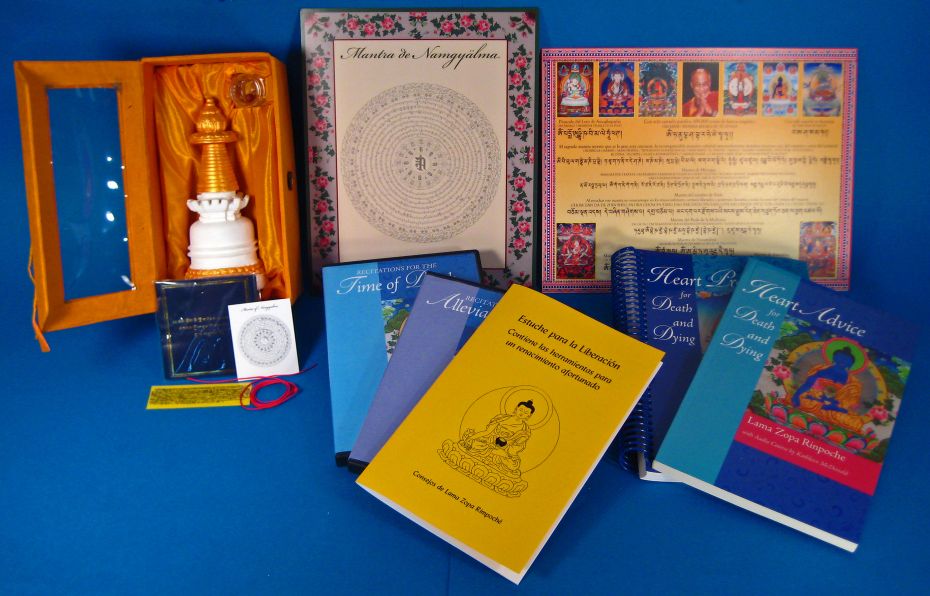
The Liberation Box: Protection Tool for a Fortunate Rebirth
Of the thousands of items offered by the FPMT Foundation Store, the Liberation Box: Tools for a Fortunate Rebirth is one of the most unique and special. It is a collection of materials to assist students at the time of death. Assembled according to Lama Zopa Rinpoche’s specific advice on what a person should hear, see, and have placed on their body, the Liberation Box contains powerful methods for ensuring a fortunate rebirth for those who have died or are in the process of dying.
The box includes a Kadampa stupa filled with the four dharmakaya relic mantras, a powa pill, a cord blessed by Lama Zopa Rinpoche, plus various mantras and a copy of Shetor to place on the dying person’s body. The Liberation Card for a Dying Person, a Namgyälma mantra card, and the CDs Recitations to Alleviate Pain and Recitations for the Time of Death are also included to be seen and heard by the dying person. In addition, the books Heart Practices for Death and Dying and Heart Advice for Death and Dying, and a booklet with instruction on how to use all the items and additional mantras are all part of the Liberation Box.
“So much went into creating the Liberation Box. So many people have put work into it. And it was requested by Rinpoche. The Sangha at Rinpoche’s house in Aptos, California, are involved, creating and consecrating the stupas. Volunteers bring them up to Oregon and they are painted in the Foundation Store. Every little thing has a story,” Foundation Store manager Diana Ospina said.
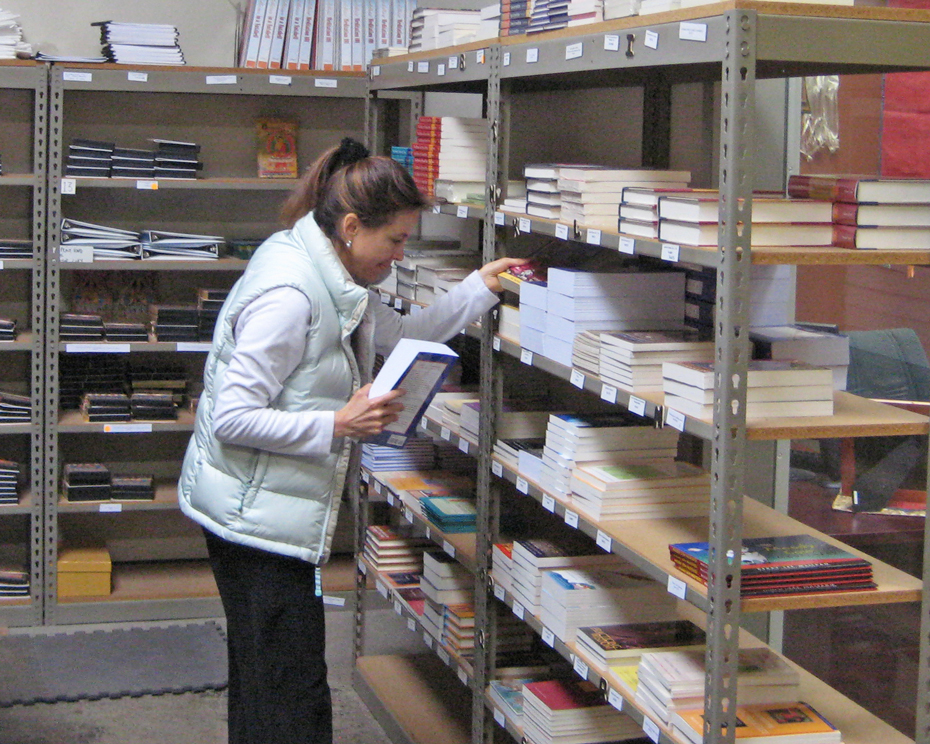
Foundation Store manager Diana Ospina looking over the book inventory in the FPMT Foundation Store, Portland, Oregon, US
The powa pill included in the box was made by either Geshe Lama Konchog or Khensur Rinpoche Lama Lhundrup at Kopan Monastery and was blessed by His Holiness the Dalai Lama in his home in Dharamsala, India, and also blessed in the FPMT International Office by His Holiness the Dalai Lama and His Holiness Sakya Trichen.
The stupa and smaller items come packed in a specially designed golden paper box from Nepal. The FPMT Foundation Store, which assembles the Liberation Box, has been making the boxes available since May 2010. To date, 745 Liberation Boxes have been distributed around the world.
“When we hear ‘Please, please, I need the Liberation Box,’ I tell you, we run to send it out,” Diana said. “And then we hear back from the customer, ‘I never will forget this box.’ There are so many stories. It is so special how it takes on meaning for each individual.”
Find the Liberation Box: Protection Tool for a Fortunate Rebirth exclusively in the FPMT Foundation Store. The Liberation Box is being offered now at a special discount while inventory lasts:
https://shop.fpmt.org/Liberation-Box-Tools-For-a-Fortunate-Rebirth–Digital-Edition_p_2416.html
A digital version of the Liberation Box is also available. Please note, the digital version does not contain the stupa, powa pill, and blessing string:
https://shop.fpmt.org/Liberation-Box-Tools-For-a-Fortunate-Rebirth–Digital-Edition_p_2416.html
Find advice from Lama Zopa Rinpoche about how to help those who are sick and dying on FPMT.org’s “Death and Dying: Heart Practices and Advice”:
https://fpmt.org/death/
Read about the FPMT Foundation Store in “The Foundation Store: Sending Dharma to Every Corner of the World” from Mandala eZine May 2011:
https://fpmt.org/wp-content/uploads/2019/04/18/ensuring-a-fortunate-rebirth-the-liberation-box/The-Foundation-Store-Mandala-ezine-May-2011.pdf
- Tagged: death, death and dying, foundation store, liberation box
12
Advice for Merit Multiplying Days
Lama Zopa Rinpoche gave advice regarding merit multiplying days such as the Fifteen Days of Miracles, Saka Dawa, Chokhor Duchen, and Lhabab Duchen. The next merit multiplying day is Saka Dawa on June 17, 2019.
On the day of Guru Shakyamuni Buddha’s turning the Wheel of Dharma, if you do one prostration while reciting the names of the Thirty-Five Buddhas, it becomes equal to having done 100 million prostrations while reciting the names of the Thirty-Five Buddhas. If you recite one Vajrasattva mantra, it becomes the same as having done the Vajrasattva mantra 100 million times. If you recite the Diamond Cutter Sutra (Vajra Cutter Sutra) one time, it becomes the same as having recited the Diamond Cutter Sutra 100 million times—so that much purification and you collect that many merits to quickly be free from samsara, and if the practices are done with bodhichitta, then to quickly achieve enlightenment.
Reading the Golden Light Sutra (Sutra of Golden Light), besides the personal benefits that creates, also brings so much peace in the world, for the Buddhadharma to last a long time, which means more sentient beings being able to meet the Dharma and to achieve enlightenment. Then, also reciting the Arya Sanghata Sutra, which brings success, including enlightenment. Each recitation becomes 100 million recitations—so please tell your parents and friends this.
This is the best way to help your parents and this really helps your parents. You can tell others this also and their friends. This really helps the world, to make a better world.
Please read my notes well. Don’t rush. Think about each word.
Also on these days, you can do tonglen—taking others sufferings and giving away one’s own happiness—then, also rejoicing. You can meditate on dependent arising (meaning, emptiness only) and develop bodhichitta. Of course, you can do self-initiation during this very special time according to the time in India.
If you want to know which lama and which text mentioned this, it was His Holiness the Dalai Lama’s and His Eminence Sakya Trizin’s guru—Chobgye Trichen Rinpoche. Rinpoche referred to Guru Shakyamuni Buddha’s teaching Dulwa Lung (‘dul ba lung) as saying that the number the merit multiplies by is 100 million. It is a great advantage to practice during these times; like for myself, who is the most extremely laziest person in this world.
Another very important practice to do on these days is taking the eight Mahayana precepts for one day until the next day at sunrise. That doesn’t mean necessarily until sunrise Indian time. It means sunrise at the place where you are; up until dawn, when the sun rises in your part of the world.
In case there are difficulties to keeping all eight precepts, perhaps due to work, for example, you can take the rest of the vows well. Taking the eight Mahayana precepts is so beneficial for world peace, for crops to grow well, to receive timely rains—all this is needed to make the world better. Then, there are incredible benefits for yourself. This is explained in the book of the eight Mahayana precepts. This is so important for your own life to be better and to make the world better, to bring benefit.
Written by Lama Zopa Rinpoche, August 2017, United States. Edited by Michael D. Jolliffe for publication on FPMT.org.
Lama Zopa Rinpoche is the spiritual director of the Foundation for the Preservation of Mahayana Tradition (FPMT), a Tibetan Buddhist organization dedicated to the transmission of the Mahayana Buddhist tradition and values worldwide through teaching, meditation, and community service.
- Tagged: buddha day, merit multiplying day
4
Mantras for Protection from the FPMT Foundation Store
The Namgyalma mantra is extremely powerful and is the main mantra to purify and liberate beings from the lower realms, purify negative karma, and help those who are dying or have died either by chanting it in their ear or placing it on their body.
Lama Zopa Rinpoche has discussed many times its power and use to benefit sentient beings. The FPMT Foundation Store currently makes available several items featuring the Namgyalma mantra, including amulets, cards, and stickers.
- The Namgyalma and Lama Atisha Protection Amulet is a printed mantra packet that contains the Namgyalma Mantra Wheel and the Lama Atisha Protection Mantra. In addition to the benefits taught by Lama Zopa Rinpoche for each mantra, keeping this amulet close to one’s body protects one from harm and mental pollution.
This amulet also contains these powerful mantras: the Phagpa Chulung Rolpai Do Mantra, which upon seeing, purifies 100,000 eons of negative karma and obscurations; the Wish-Granting Wheel Mantra, which purifies one thousand eons of negative karma for anyone that passes beneath it; and the Six Syllables of Clairvoyance Mantra, which after fifteen days upon seeing, purifies any heavy negative karma created in the past.
- The Namgyalma Mantra Card (seen above) is a colorful modern take on the Namgyalma mantra and comes in two sizes.
- The Namgyalma Mantra Car Sticker is meant to be put on your car so that when insects inevitably die as you drive, the Namgyalma mantra helps to purify their negative karma and support their good rebirth.
In addition, the Foundation Store offers a Vairochana Mantra card. Lama Zopa Rinpoche has said, “Just by reciting this mantra one receives success, and one does not get harmed by weapons, fire, water, poisons, substances mixed with poisons, black magic, one cannot be harmed by kings, thieves, robbers, and so forth. Wherever this mantra is written and left, people do not receive sicknesses, harm and contagious diseases and will achieve the concentration called stainless light.”
The Foundation Store also offers Mantra Stickers—Protection From Negative Energies. There are three stickers available: the mani mantra, the Shakyamuni Buddha mantra, and also Kalachakra yantra.
Since all of these mantras are to be seen as holy objects, students are reminded to take care when placing the stickers, cards, and amulets, and demonstrate proper respect for them.
For more on mantras, visit FPMT Education’s “Mantra” resource page:
https://fpmt.org/education/prayers-and-practice-materials/mantras/
Find more protection and practice items at the FPMT Foundation Store:
https://shop.fpmt.org/
Through comprehensive study programs, practice materials, and training seminars, FPMT Education nourishes the development of compassion, wisdom, kindness, and true happiness in individuals of all ages.
- Tagged: foundation store, lama atisha's protection stupa, namgyalma mantra, protection, vairochana mantra
28
Lama Zopa Rinpoche recommended in early 2019 that it would be good for FPMT centers, projects, and services to have access to a particular image of the Wheel of Life. Lama Zopa Rinpoche asked that a translated verse be included with the image.
The verse reads:
Energetically undertake THIS and renounce THAT. The one who engages in this Dharma that subdues the mind VINAYA. Like an elephant in a mud hut, destroys the domain of the Lord of Death. The one who is extremely conscientious and careful engages in this Dharma that subdues, thoroughly abandoning the wheel of birth and bringing suffering to an end.
This image of the Wheel of Life was painted at Tushita Meditation Centre, India, at Rinpoche’s request. The creation of the painting was overseen by Jhado Rinpoche.
Lama Zopa Rinpoche considers this particular image of the Wheel of Life to be correct.
Lama Zopa Rinpoche also recommended that it would be good for FPMT centers, projects, and services to have access to an image of Guru Shakyamuni Buddha with the Seventeen Pandits.
The Seventeen Pandits, according to “The Seventeen Pandits of Nalanda Monastery” by the late FPMT student and Buddhist scholar Dr. James Blumenthal, “refers to a grouping of seventeen of the most important and influential Mahayana Buddhist masters from India’s past.”
Find the downloadable images of Wheel of Life and Guru Shakyamuni Buddha with the Seventeen Pandits by donation in the Foundation Store:
https://shop.fpmt.org/Wheel-of-Life–PDF-_p_3203.html
https://shop.fpmt.org/Guru-Shakyamuni-Buddha-with-the-Seventeen-Pandits–PDF_p_3202.html
Through comprehensive study programs, practice materials, and training seminars, FPMT Education nourishes the development of compassion, wisdom, kindness, and true happiness in individuals of all ages.
- Tagged: seventeen nalanda pandits, wheel of life
21
Take a Look! Flower Offering Card
Lama Zopa Rinpoche created the Flower Offering Card as a welcoming and explanatory sign for anyone visiting the gardens of his house in Aptos, California, United States. Rinpoche said that any student is welcome to use the same sign in front of their own offerings.
The card reads:
Every single flower here is offered to Buddha, Dharma and Sangha, on behalf of every single sentient being in each realm, numberless hell beings, numberless hungry ghosts, numberless animals in the numberless universes, every single fish in the ocean size as large as a mountain and ones who are so small that you can only see through a machine, numberless pitiful ants, numberless pitiful mosquitos, numberless pitiful maggots, slugs, tiny crabs at the beach and so forth, every animal, numberless human beings in different universes, numberless suras and asuras to be free from the oceans of samsaric sufferings and the causes and to achieve peerless happiness, the cessation of all the obstacles and completion of all the realizations.
This means every single flower is every sentient being’s offering and this is similar with the water offerings, it is offered from every sentient being and is every sentient being’s water offering.
Thank you very much.
Find the Flower Offering Card in the Foundation Store:
https://shop.fpmt.org/Flower-Offering-Card_p_2532.html
Through comprehensive study programs, practice materials, and training seminars, FPMT Education nourishes the development of compassion, wisdom, kindness, and true happiness in individuals of all ages.
- Tagged: flower offering, flower offerings, foundation store, offering, offerings
14
Students can now find two texts—Meditations on White Tara and A Meditation on Orange Manjushri—in ebook and PDF formats.
Meditations on White Tara contains practices to strengthen and restore health and life-force energy. By relying on White Tara, students are able to accumulate merit and purify negative karma in order accomplish their aims. If one has experienced many health problems, accidents, depression, or a loss of vitality, the practices of White Tara might be helpful.
These White Tara meditations can also be done on behalf of oneself or others, and are frequently done to remove obstacles to the long lives and health of one’s gurus.
A Meditation on Orange Manjushri includes “A Meditation on Orange Manjushri,” a short sadhana written by the Fifth Dalai Lama as well as “Practice to Receive the Seven Types of Wisdom.” These practices are considered excellent for developing wisdom and clarity, improving one’s memory, and for understanding and explaining Dharma to others.
Through comprehensive study programs, practice materials, and training seminars, FPMT Education nourishes the development of compassion, wisdom, kindness, and true happiness in individuals of all ages.
- Tagged: manjushri, orange manjushri, white tara
7
Find Lamrim Resources on FPMT.org
Find lamrim resources—including teachings, commentaries, prayers, audio programs, comprehensive study programs, and year-long meditation schedules—on FPMT.org to assist your study and practice.
“The most unbelievably important thing in our life is lamrim,” Lama Zopa Rinpoche stresses in “Advice for Realizing Lamrim,” an online module within FPMT’s essential lamrim study program Living in the Path. “The practice of the three principal aspects of the path is the most important thing. This is the most important, more important than a job, money, or anything else in our life. It is the most important thing.”
In March 2013, Lama Zopa Rinpoche gave advice suggesting that students follow a lamrim outline and meditate on each subject for two weeks or one month until all subjects have been completed. “The amount of time for meditation is up to the individual, but the general advice is to finish the lamrim in one year,” Rinpoche said. “To meditate like this each year—wow, wow, wow! That would be great.”
To follow this advice, consider using FPMT Education Service’s lamrim schedule template—available as an Excel spreadsheet and PDF—to help you plan daily lamrim meditation over the course of a calendar year. The template was created on the basis of the book The Essential Nectar, a commentary by Geshe Rabten on The Essential Nectar of Holy Doctrine, an 18th-century lamrim text by Yeshe Tsöndru.
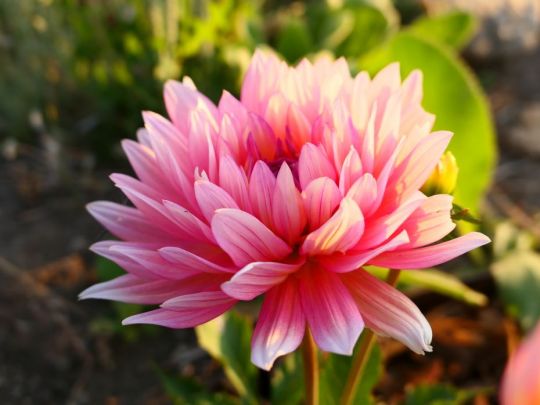
Flower offering, Buddha Amitabha Pure Land, Washington, US, August 2018. Photo by Ven. Roger Kunsang.
Find lamrim resources on FPMT.org:
https://fpmt.org/education/prayers-and-practice-materials/lam-rim/
Through comprehensive study programs, practice materials, and training seminars, FPMT Education nourishes the development of compassion, wisdom, kindness, and true happiness in individuals of all ages.
- Tagged: lamrim
28
New! ‘Recognizing the False I’ by Lama Zopa Rinpoche
Recognizing the False I, written by Lama Zopa Rinpoche, is a commentary on and set of simple meditation techniques for identifying the object to be refuted—what Rinpoche calls “the false I”—during reflections on emptiness.
The text was specifically composed for students engaging in the self-generation portion—often called “the ultimate deity”—of kriya yoga tantric practices, such as nyung nas. The meditations can also be used by students during retreats on the Heart Sutra or any other retreat focused on emptiness.
Additionally, Rinpoche offers these techniques to all students in general to help them meditate on emptiness correctly during their daily practices.
Find Recognizing the False I by donation in the Foundation Store:
https://shop.fpmt.org/Recognizing-the-False-I-eBook-PDF-_p_3552.html
Through comprehensive study programs, practice materials, and training seminars, FPMT Education nourishes the development of compassion, wisdom, kindness, and true happiness in individuals of all ages.
- Tagged: emptiness, recognizing the false i
21
‘Bodhichitta Mindfulness,’ A Living in the Path Module
In the complimentary Living in the Path module “Bodhichitta Mindfulness,” Lama Zopa Rinpoche shows students how to take the essence of our precious human life by transforming our normal daily activities—walking, washing, dressing, etc.—into a cause of enlightenment by doing them with a bodhichitta motivation to benefit all sentient beings.
“The sutra explains that in the morning when one wakes up, the very first thing to do when one wakes up from sleep is to think, ‘May all sentient beings achieve the dharmakaya.’ Lama Zopa Rinpoche teaches. “The minute you wake up, you should think that. Maybe the eyes are still closed, the mind woke up but the eyes are still closed—I’m joking—remember that.”
“Then when you get dressed, think, ‘May all sentient beings wear the dress of shyness and shame.’ …
“When you put on a belt, think, ‘May sentient beings’ minds be bound by the three higher trainings.’ These are the higher trainings of morality, concentration, and special insight. Because that is what is said in sutra, when you release a belt, think, ‘May sentient beings be freed from the bondage of karma and delusions.’
“When you lay down to go to bed, ‘May sentient beings achieve the dharmakaya.’ Then the same thing when you see a stupa. When you see a stupa or other holy object, think, ‘May all sentient beings achieve the dharmakaya.’ When you see a holy object such as a Buddha statue, ‘May all sentient beings achieve enlightenment quickly.’ You can dedicate like that.”

Lama Zopa Rinpoche cooking with Ven. Tharchin, Buddha Amitabha Pure Land, Washington, US, June 2018. Photo by Ven. Lobsang Sherab.
“Bodhichitta Mindfulness” is available through the FPMT Online Learning Center:
https://onlinelearning.fpmt.org/course/view.php?id=120
Living in the Path is an online lamrim program taught by Lama Zopa Rinpoche available through the FPMT Online Learning Center:
https://onlinelearning.fpmt.org/course/index.php?categoryid=5
Through comprehensive study programs, practice materials, and training seminars, FPMT Education nourishes the development of compassion, wisdom, kindness, and true happiness in individuals of all ages.
14
Take a Look! Purifying the Cause of Samsara Door Card
Lama Zopa Rinpoche designed the Purifying the Cause of Samsara door card as an easy way for students to regularly purify negative karma.
To use the card, place it above your door in order to benefit from the two main mantras it features. The mantra “OM HANU PAHASHA BHARA HE YE SVAHA,” when seen, purifies 100,000 eons of negative karma and obscurations. The Wish-Granting Wheel mantra, “OM PADMO USHNISHA VIMALE HUM PHAT,” when passed under, purifies 1,000 eons of negative karma and obscurations.
Rinpoche teaches that beings only receive the benefit of these door blessing mantras if they walk directly underneath them. With this in mind, Rinpoche recommends that students acquire a sufficient number of mantra cards to take up the width of the door frame.
Find the Purifying the Cause of Samsara door card by donation in the Foundation Store:
https://shop.fpmt.org/Purifying-the-Cause-of-Samsara–Above-the-Door-Mantra-Card_p_1752.html
Through comprehensive study programs, practice materials, and training seminars, FPMT Education nourishes the development of compassion, wisdom, kindness, and true happiness in individuals of all ages.
- Tagged: card, purifying the cause of samsara
- Home
- News/Media
- Study & Practice
- About FPMT Education Services
- Latest News
- Programs
- New to Buddhism?
- Buddhist Mind Science: Activating Your Potential
- Heart Advice for Death and Dying
- Discovering Buddhism
- Living in the Path
- Exploring Buddhism
- FPMT Basic Program
- FPMT Masters Program
- FPMT In-Depth Meditation Training
- Maitripa College
- Lotsawa Rinchen Zangpo Translator Program
- Universal Education for Compassion & Wisdom
- Online Learning Center
- Prayers & Practice Materials
- Overview of Prayers & Practices
- Full Catalogue of Prayers & Practice Materials
- Explore Popular Topics
- Benefiting Animals
- Chenrezig Resources
- Death & Dying Resources
- Lama Chopa (Guru Puja)
- Lama Zopa Rinpoche: Compendium of Precious Instructions
- Lama Zopa Rinpoche: Life Practice Advice
- Lama Zopa Rinpoche Practice Series
- Lamrim Resources
- Mantras
- Prayer Book Updates
- Purification Practices
- Sutras
- Thought Transformation (Lojong)
- Audio Materials
- Dharma Dates – Tibetan Calendar
- Translation Services
- Publishing Services
- Teachings and Advice
- Find Teachings and Advice
- Lama Zopa Rinpoche Advice Page
- Lama Zopa Rinpoche: Compendium of Precious Instructions
- Lama Zopa Rinpoche Video Teachings
- ༧སྐྱབས་རྗེ་བཟོད་པ་རིན་པོ་ཆེ་མཆོག་ནས་སྩལ་བའི་བཀའ་སློབ་བརྙན་འཕྲིན།
- Podcasts
- Lama Yeshe Wisdom Archive
- Buddhism FAQ
- Dharma for Young People
- Resources on Holy Objects
- Ways to Offer Support
- Centers
- Teachers
- Projects
- Charitable Projects
- Make a Donation
- Applying for Grants
- News about Projects
- Other Projects within FPMT
- Support International Office
- Projects Photo Galleries
- Give Where Most Needed
- FPMT
- Shop
Translate*
*powered by Google TranslateTranslation of pages on fpmt.org is performed by Google Translate, a third party service which FPMT has no control over. The service provides automated computer translations that are only an approximation of the websites' original content. The translations should not be considered exact and only used as a rough guide.Letting go of attachment brings inner satisfaction and peace.
